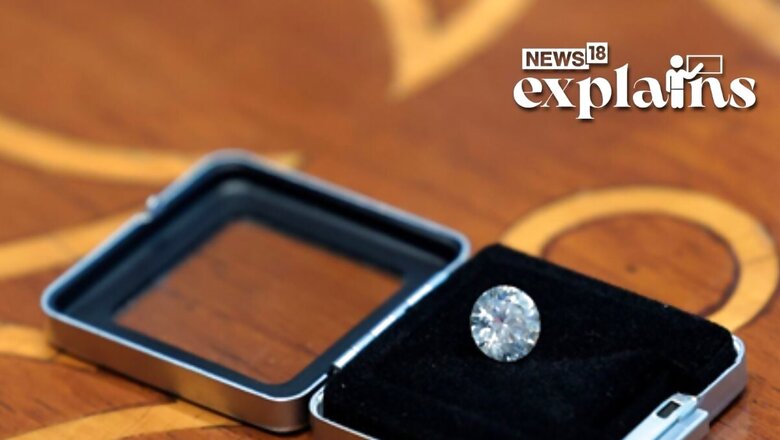
views
The 7.5 carat eco-friendly lab-grown diamond, which Prime Minister Narendra Modi gifted to the US First Lady Jill Biden in Washington during his ongoing state visit, has been manufactured in a Surat factory in Gujarat by recreating the same process that takes place beneath the earth in formation of natural diamonds.
What is a Lab-grown Diamond & How is It Made?
Lab-grown diamonds (LGDs) are much in demand now and the Indian government has decided to promote them in a big way to boost the diamond industry, which has its headquarters in Surat in Gujarat, as per a PTI report.
Union Carbide claimed to have created the first chemical vapor deposition (CVD) diamond in 1952, while other producers were using the high-pressure, high-temperature (HPHT) technology to produce diamonds. These diamonds were primarily used in industries such as telecommunications and laser optics. However, it was in the 1970s that researchers at General Electric first succeeded in creating gem-quality laboratory-grown diamonds. Around the same time, scientists at the Gemological Institute of America (GIA) conducted the first scientific study of these laboratory-grown diamonds, according to a report by the Hindu Business Line.
Laboratory-grown diamonds (LGDs) possess physical and optical properties similar to those of natural diamonds. They are indistinguishable from natural diamonds to the naked eye, requiring trained gemologists and advanced equipment to tell them apart, the report says.
The size, clarity, cut, and color of LGDs make them suitable alternatives to natural diamonds, particularly when the availability of natural diamonds becomes limited due to depleting reserves and rising costs.
The production of lab-grown diamonds involves a different process compared to the natural diamond formation that takes centuries or even millennia under extreme heat and pressure beneath the Earth’s crust. LGDs are created in laboratories using either the CVD or HPHT method, and it takes less than a month to produce a distinctively-shaped crystal.
The process begins with a seed, which is a slice of another diamond, serving as the foundation for the LGD growth. In the HPHT method, the seed and graphite carbons are subjected to high temperatures (1,500 degrees Celsius) and extreme pressures that simulate the conditions necessary for the formation of natural diamonds beneath the Earth’s surface.
In China, most of the LGDs are produced using the HPHT method, according to the report. In India, the CVD (chemical vapor deposition) method is more widely used for the production of lab-grown diamonds. In the CVD process, a seed is placed in a sealed chamber filled with carbon-rich gas molecules, typically methane. The seed is then heated up to around 800 degrees Celsius.
By Which Method Was the Diamond Gifted to Jill Biden Made?
Talking to PTI in Surat, Smit Patel, convenor of the Gem & Jewellery Export Promotion Council (GJEPC), said the diamond gifted by Modi to the US First Lady was grown in India using CVD technology that creates the purest form of diamonds.
“The Kohinoor was a type Two A pure diamond. This diamond (gifted by PM) is 7.5 carat, which represents the 75 years of Independence. This diamond was also created using green energy. So that is also a step towards showing that India is moving towards green and renewable energy — a goal espoused by PM Modi himself,” said Patel.
GJEPC lab-grown diamond convenor Patel said India has mastery over the CVD technology and most of the LGDs produced in India are produced using this technique.
“This is like an IVF (in vitro fertilization) baby. After the IVF baby is born, looking at the baby nobody can say the difference. In the same way, diamonds produced using the CVD technology have the same quality, hardness as natural diamond,” Patel said. He said the 7.5 carat diamond gifted by Modi was manufactured in a Surat-based lab.
Chairman of Surat-based Indian Diamond Institute Dinesh Navadiya told PTI, “Diamonds are formed naturally deep underneath the earth surface, when carbon deposits are subjected to high temperature and pressure. It can take millions of years to form the crystal. Diamonds come to the earth’s surface through volcanic eruptions.”
The process involved in the formation of natural, earth-mined precious stones is adopted in a facility for lab-grown diamonds, he said.
“We procure diamond seed (chips of other diamonds), and then it is subjected to intense heat and pressure along with high carbon-containing gases. Layers of carbon start depositing on seeds and after a month-long process turn out to be a lab-grown diamond,” Navadiya explained.
“Natural diamonds take millions of years to form, while LGDs are manufactured in a matter of a few weeks. There is no difference between the two as the process is the same,” he maintained.
On an average a diamond like this size would take around two months to grow, cut and polish, he said. “Everyone in the diamond industry is so proud and emotional because this is such a big promotion for everyone in this industry,” he said.
Potential in LGD Diamonds
Vipul Shah, chairman of GJEPC, India’s apex body supported by the Ministry of Commerce and Industry, told PTI the country has made stellar advancements in the lab-grown diamond sector.
“We are happy to note that Prime Minister Narendra Modiji gifted 7.5 carat ‘green’ lab-grown diamond (LGD) to US First Lady Dr Jill Biden during a private dinner at the White House in Washington. This remarkable gesture highlights the exemplary advancements made by India in the lab-grown diamond sector,” said Shah.
He said India has also seen a robust rise in export of LGDs.
“Today, India is the largest player in growing of Chemical Vapor Deposition (CVD) lab-grown diamonds. Presenting a 7.5 carat lab-grown diamond in the 75th year of Independence highlights India’s leadership in the LGD sunrise sector. It is also a great example of the Make in India story after attaining undisputed global leadership in natural diamonds. India’s exports of LGD has grown exponentially and crossed USD 1.67 billion mark in 2022- 2023,” Shah said.
Lab-made diamonds are developed from a carbon seed placed in a microwave chamber and superheated into a glowing plasma ball. The process creates particles that crystallize into diamonds in weeks, said a report by Prabhudas Lilladher, a research-driven financial services firm.
“Since the 1950s, scientists have been trying to recreate that process above ground – resulting in two techniques. The High Pressure, High Temperature (HPHT) system is where a diamond seed is surrounded by pure graphite (a type of carbon) and exposed to temperatures of about 1,500C and pressurised to approximately 1.5 million pounds per square inch in a chamber,” said the report.
The Chemical Vapour Deposition (CVD) process involves putting the seed in a sealed chamber filled with carbon-rich gas and heating to around 800C. The gas sticks to the seed, building up a diamond atom by atom, it explained.
“These days, a one carat diamond – a popular size and common in engagement rings – made in a lab would be around 20 per cent cheaper than its naturally-formed equivalent,” the report said.
India already produces around three million (30 lakh) lab-grown diamonds a year, accounting for 15 per cent of global production, according to the Ministry of Commerce and Industry.
China is the other big producer, with a similar market share, industry experts said.
India witnessed a sharp rise in LGD exports worth USD 443 million which rose 102 per cent year-on-year. The Prabhudas Lilladher report said even at the start of 2020, lab-grown diamond exports in India were up 60 per cent Y-o-Y, while natural diamond exports were down by 41 per cent Y-o-Y.
PTI contributed to this report

















Comments
0 comment